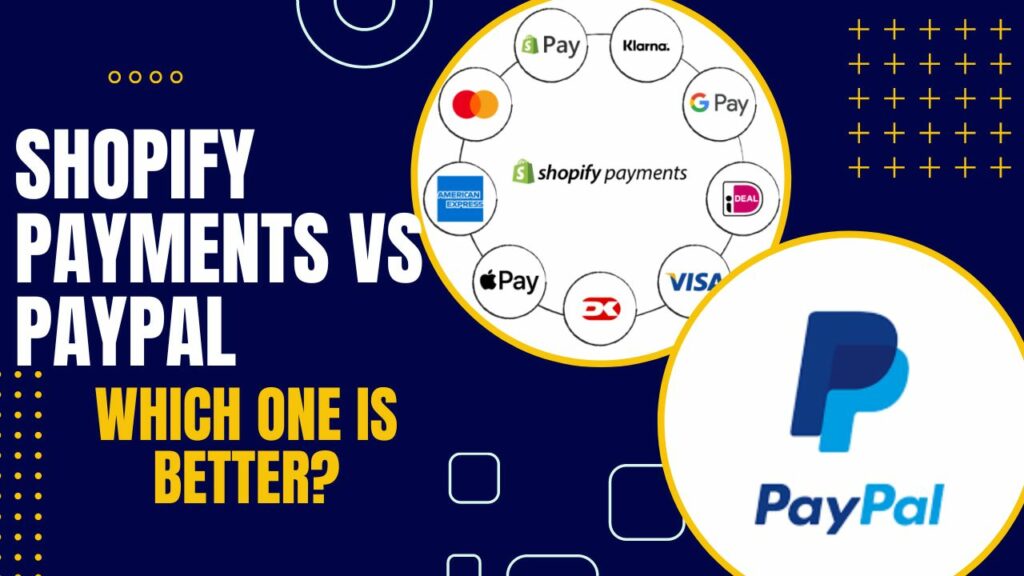Shopify is arguably one of the most popular and widely-used eCommerce platforms up to date. Whether you own a Shopify store or a customer, one of the most important things you consider when making transactions are the payment methods or Shopify payment gateway you can use. In this article, we will share with you two of the most used and compare them: Shopify Payments VS PayPal.
Shopify Payments VS PayPal: A thorough comparison between the two
Before you decide which payment provider to use, it’s best that you first know their key features, what they lack, and compare the two. That’s when it is easier for you to decide which of the payment options fit your needs.
Choosing the best payment provider is one of the most important decisions you will make as a Shopify store owner. You will have various factors to consider like the payments fee, payout frequency, and more. We will go through each payment method first so you will have a better understanding on what they can offer their customers.
Shopify Payments: An overview
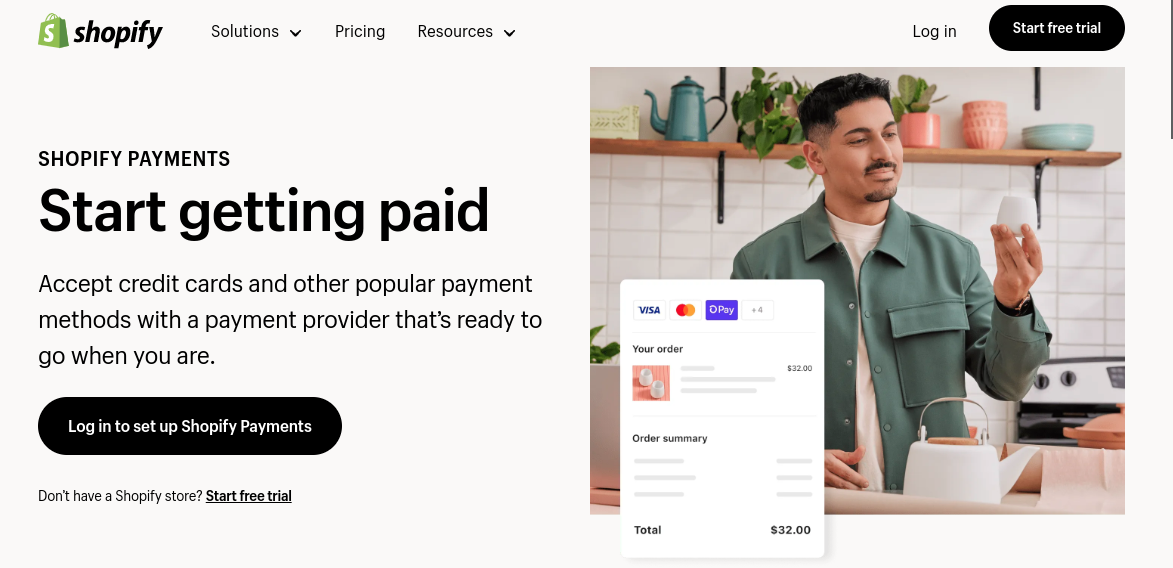
Shopify provides a complete solution that helps merchants launch their online business seamlessly. This is why it is considered as one of the best and famous online platforms today. One thing that makes Shopify stand out from the rest of the platforms is that it gives the best customer experience.
With its growing users: from customers and business owners, Shopify has come up with an optimized and integrated payment solution which is Shopify Payments. Launched in 2013, Shopify Payments is relatively new compared to PayPal. Despite that, it has gained popularity because its features are user friendly.
Shopify Payments: Pros
Being one of the most popular and widely used payment platforms in Shopify, Shopify Payments sure has a lot of pros. Here’s a list of them:
- Shopify Payments is a built-in or internal feature. As a Shopify online store owner, one of the pros of Shopify Payments is that it is built internally in Shopify. This means that it can easily integrate into your online store without taking a lot of time.
- Less transaction fees charges. Since it is an internal feature, there will be no need for you to use third-party payment platforms in Shopify. Shopify Payments charges less transaction fees compared to its competitors.
- Quick payouts. With Shopify Payments, getting your payouts transferred to your bank account can take only 3 business days or less. This is quicker compared to its competitors.
- Access to analytics. You will also be able to have access to analytical and business solutions with Shopify Payments. With this feature, you will have visibility on your sales, pending payments, payments, and Shopify fees. In other words, this payment platform helps you make decisions that are data-driven and plan strategies on making your business successful.
Shopify Payments: Cons
While there are a lot of great features Shopify Payments offer, there are also a few cons in using this payment provider. Here’s the list:
- Asks for personal and sensitive information. One of the most common concerns of customers with using Shopify Payments is having to share their personal and sensitive information through the store’s website. When using this platform, customers will have to enter their credit card information when they check out. It’s not easy to trust online stores, so most customers prefer third party platforms when paying.
- Your website should be set up with Shopify. Since Shopify Payments is an internal feature, you will only be able to use it if your store is set up with Shopify. So, if you are not currently using Shopify or planning to switch platforms, that means you won’t or will no longer have access to Shopify Payments.
PayPal: An overview
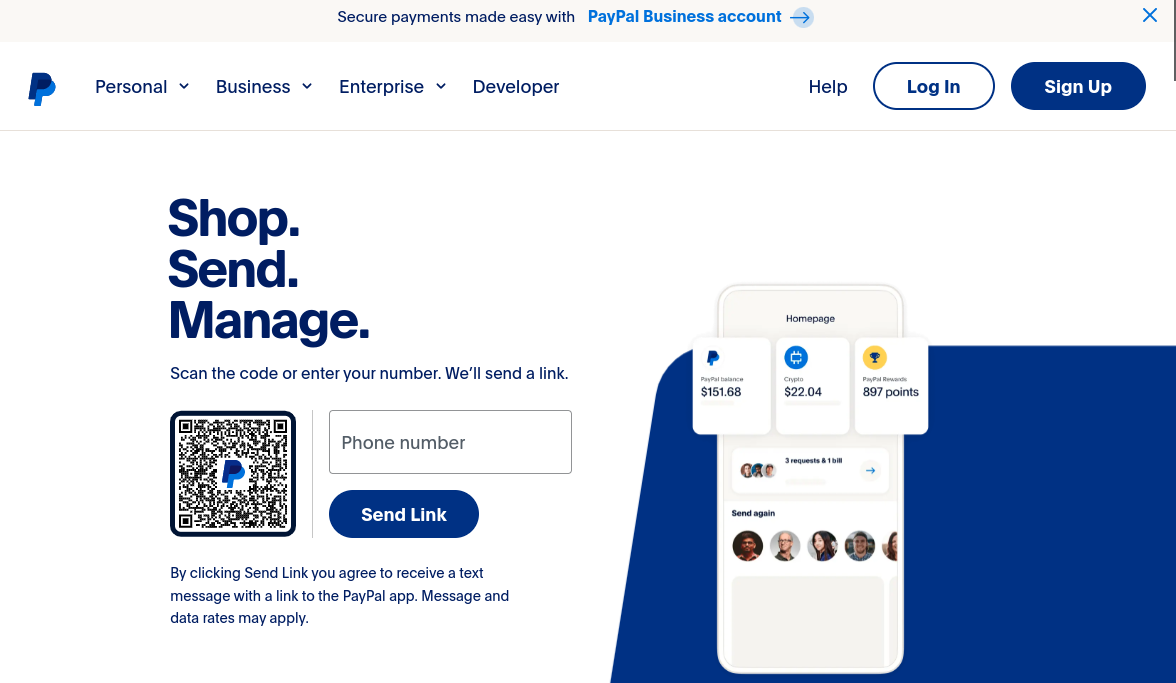
PayPal is one of the leading and reliable payment platforms. You may be wondering if Shopify also accepts other payment methods such as PayPal, the answer is yes. And it is actually one of the best alternatives to Shopify Payments since you can integrate it with Shopify easily.
Once you’ve added PayPal to your online store, your customers will be given an option to also pay with Paypal. It is a good option for customers since it’s more secure and they won’t have to enter their credit card details upon checking out.
PayPal: Pros
Being in the industry for so long, PayPal sure comes with a lot of pros. Here’s a list of them:
- Trusted and reliable. Many customers trust PayPal because it has proven itself as being one of the most secured and trusted payment platforms.
- Seller and Buyer Protection Program. When your customer doesn’t receive the item or unauthorized transactions, PayPal’s seller protection program protects you from reversals, chargebacks, and claims for the full amount. On the other hand, buyer protection includes refunds for incorrect and orders that didn’t arrive.
- Easy payment processing. Repeat customers more likely have their PayPal accounts saved on Shopify as their payment processor. This means that it will be easier for them to make purchases from your store.
PayPal: Cons
You and your customers are protected when using PayPal. But there are additional things that you need to know before using it as your payment provider. Here’s some of them:
- Third-party payment provider. When making a payment to buy products on Shopify, customers will be directed to a different browser. This affects customer satisfaction since it means adding a few more extra steps to complete one transaction.
- High payment and transaction fees. PayPal’s transaction fees are a bit higher compared to other platforms including Shopify Payments.
Also see: Top 12 eCommerce Software with Inventory Management in 2023
Shopify Payments VS PayPal: Which one is better?
Choosing between Shopify Payments and Shopify can be quite hard, as both of them have their own advantages and disadvantages. The good news is, as a Shopify store owner, you don’t have to choose between the two. This is because you can integrate both Shopify Payments and PayPal on your online store easily.
Adding both payment providers to your store lets you offer your customers a choice when processing their payments, making their checkout process a lot smoother. However, every business is unique, so it is up to your judgment on which one works best for you, your customers, and your store.
To better help you decide, we will compare both payment platforms: Shopify Payments vs PayPal based on key factors that are important to online businesses.
1. Cost and fees
Shopify Payments Fee
Being an internal payment feature, Shopify Payments eliminates the need for an additional third-party provider, making it a better choice when it comes to cost.
If you are considering accepting credit card payments, you will be charged credit card processing fees per transaction. This will depend on your current plan and may cost around 2.4% to 2.9% + 30 cents.
PayPal Fees
As a third-party provider, PayPal charges higher fees compared to internal platforms. If you sell in the US, you will be charged 2.9% of the transaction amount plus a flat fee of 30 cents. For sales outside the US, you’ll pay 4.4% of the transaction plus a fixed fee based on the currency.
Our verdict: Using Shopify Payments can save you 0.5% to 2% in transaction fees compared to PayPal, making it the more budget-friendly option.
2. User experience
Shopify Payments user experience
One of the standout benefits of Shopify Payments is its ease of use and seamless integration. It is straightforward to set up, with just a few clicks from your Shopify admin.
To integrate Shopify Payment gateway into your checkout, follow these steps:
- Go to “Settings”
- Select “Payment Providers” Choose “Shopify Payment setup”
Setting up Shopify Payment gateway may require additional information depending on your location. This may include adjusting your currency settings, adding personal information, or taking other actions. Nevertheless, the process is still efficient and straightforward. Additionally, customers will find it easy and quick to enter their credit card information and complete their transactions.
PayPal user experience
In comparison, adding PayPal as your payment provider is more complicated and time-consuming. It’s because you will need to set up a PayPal payment gateway on your website. However, when your customers make a payment, PayPal will redirect them to its website to complete the transaction. This extra step can be frustrating for customers and may negatively impact your conversion rate.
Our verdict: When it comes to user experience, Shopify Payments is a better option. It’s easier when it comes to integration and setting up.
3. Payout Schedule
Shopify Payments payout schedule
The electronic transfers you make through Shopify Payments could take around three business days to be processed, considering that you are located in the United States. Payout schedule may vary depending on your location. You will be able to monitor the status of your payout real-time through the Shopify dashboard.
PayPal payout schedule
When you use PayPal, your payout could take 5-7 business days to process. You will be able to access the status of your transaction 24/7.
Our Verdict: Shopify Payments is better when it comes to payout schedules because it only takes a few days, compared to PayPal where your payout could take more than a week (plus the weekends) to process.
4. Dispute Resolution
Shopify Payments dispute resolution
When it comes to handling claims, Shopify Payment takes a thorough approach by gathering evidence from both the seller and the customer before making their final decision within 60 days. This process is generally considered to be efficient and effective.
However, if your customer wins a chargeback dispute and is refunded, you will face a penalty of $15 per chargeback. If this occurs repeatedly, your online store and available sales account may be permanently locked.
PayPal dispute resolution
With PayPal, you also have the opportunity to respond to claims or disputes related to transactions. If there is a claim, you will have 10 days to provide evidence and your funds will be temporarily frozen. PayPal may take up to 75 days or more to resolve the dispute between you and the customer.
PayPal imposes a chargeback fee of $20 on valid claims. However, if your transactions meet certain criteria, the PayPal Seller Protection program will cover this fee for you.
Our verdict: When it comes to dispute resolution, Shopify Payment gateways is more efficient and charges $5 less on chargebacks compared to PayPal.
5. Customer Support
Since both Shopify Payments and PayPal are one of the best payment options, both have impressive customer service support. Whenever you need help with your account, their support can take care of your concerns within 24 business hours.
How to add PayPal to Shopify?
Since PayPal is a third party service, you will need your PayPal payment gateway added to your Shopify account. Note that you need to have a PayPal business in order to connect it to Shopify. Additionally, you also have to use the same email address for both accounts.
Here’s how you link your PayPal payment gateway business account to Shopify:
1. On your Shopify Admin Dashboard, look for and click on “Settings,” then go to “Payments.”
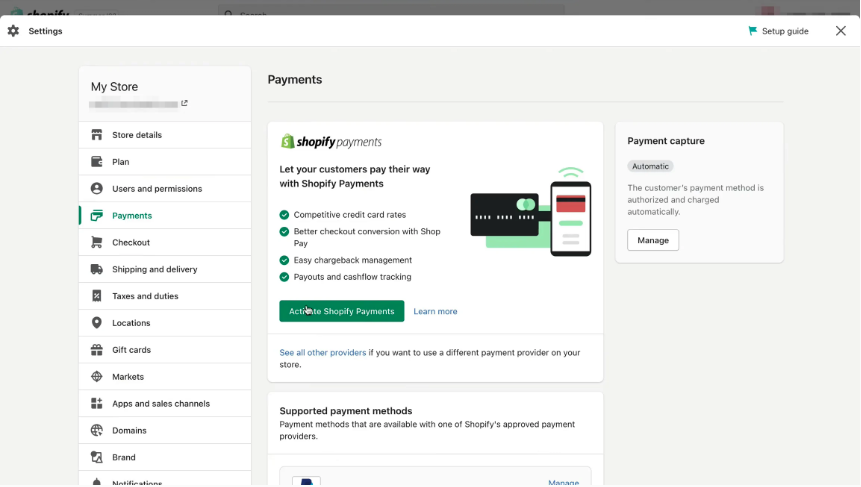
2. Under “Supported payment methods,” look for “PayPal” and click on “Manage” at the upper right corner. Then, click on “Complete setup.”
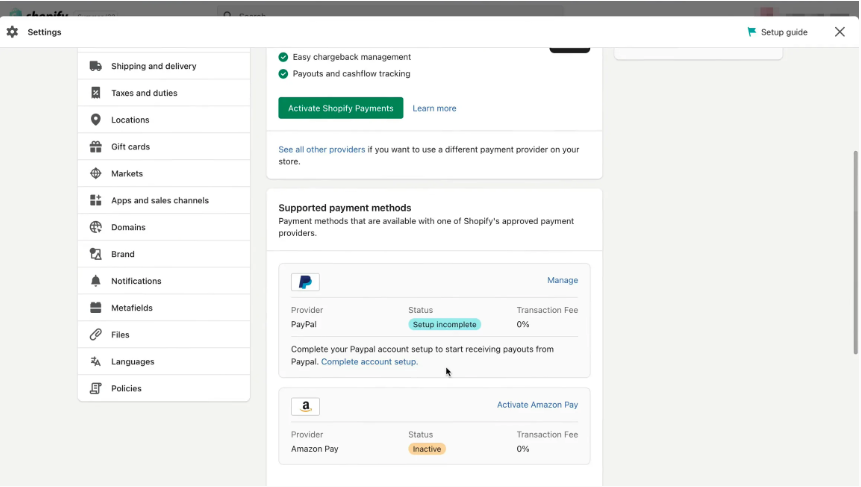
3. You will be directed to a permissions page. Just click on “I Give Permission” to allow PayPal to connect to your Shopify account.
Also see: 10 Best Shopify Page Builders in 2023
Shopify Payments VS Shopify: Frequently asked questions
Can I use PayPal transaction instead of Shopify Payments?
Yes. If you decide that you want to use PayPal instead, you may connect your PayPal business account to your Shopify account. You can also use both so you can give your customers another payment option should they prefer using Shopify Payments.
What is the best payment method for Shopify?
There are various reliable and credible payment methods you can use on Shopify. Which one to choose will still depend on your needs and preferences since each of them have pros and cons. In this article, we compared Shopify Payments vs PayPal, including their pros and cons. Use it as a basis for your decision.
Is it better to use Shopify Payments vs PayPal?
When it comes to cost and fees and payout schedule, Shopify Payments is a great payment method option to use in Shopify.

